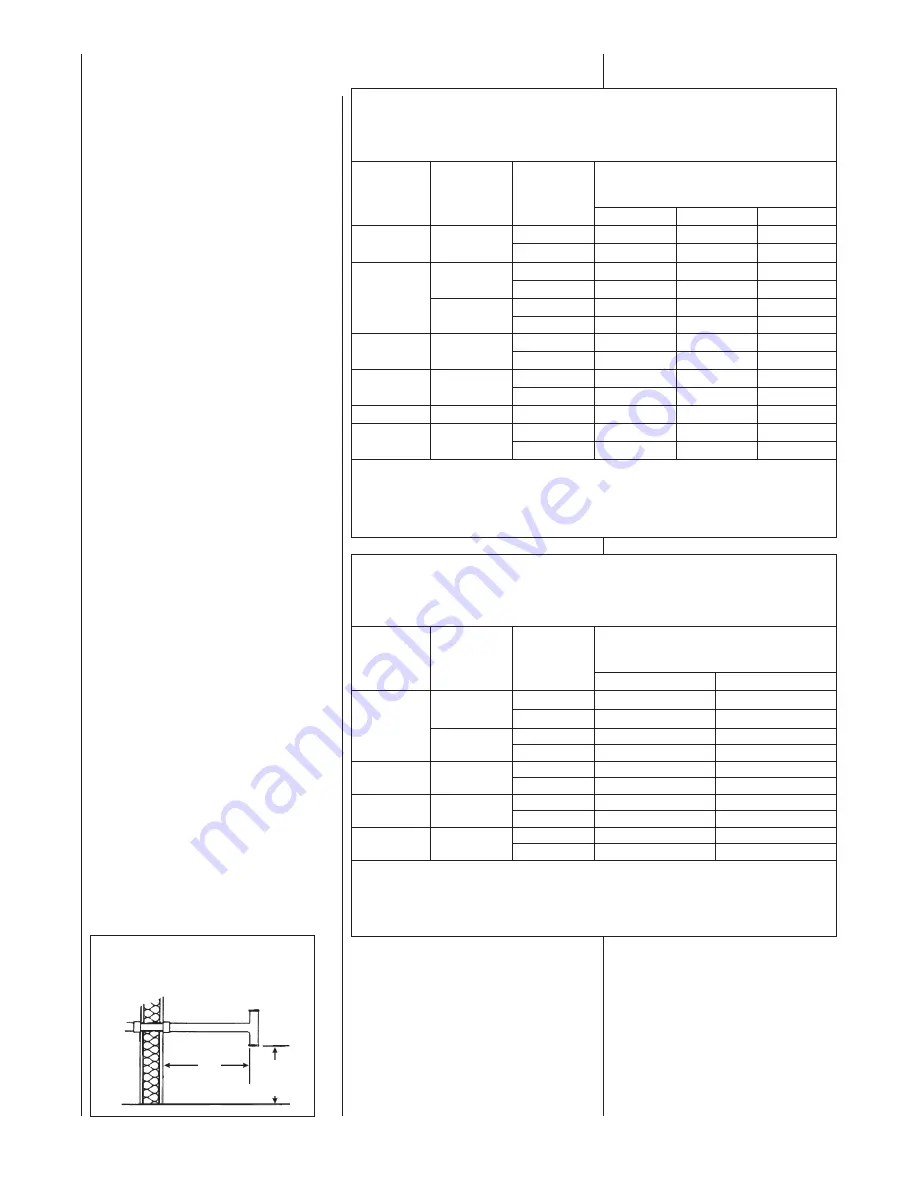
20
NON-DIRECT VENT
INSTALLATION
GUIDELINES
IMPORTANT:
Failure to correctly follow
all venting guidelines may result in
erratic furnace operation, freeze-up of
combustion air or exhaust air piping or
sooting of the furnace.
All exhaust piping must be installed in
compliance with Part 7, “Venting of
Equipment,” of the latest edition of the
National Fuel Gas Code NPFA54/ ANSI
Z223.1-, local codes or ordinances and
these instructions.
1. Vertical piping is preferred.
2. All horizontal piping must slope
upward a minimum of
1
/
4
inch per
foot of run so that condensate drains
toward the furnace.
3. All horizontal runs must be
supported at least every 4 feet. No
sags or dips are permitted.
4.
IMPORTANT:
Do not common vent
with any other appliance. Do not
install in the same chase or chimney
with a metal or high temperature
plastic pipe from another gas or fuel-
burning appliance unless the
required minimum clearances to
combustibles are maintained
between the pvc pipe and other
pipes.
5. All vent runs through unconditioned
spaces where below-freezing
temperatures are expected should
be insulated with 1-in. thick,
medium-density, foil-faced
fiberglass. An equivalent “arm-a-
flex” or “rub-a-tex” insulation may
also be used as long as there is no
heat tape applied to the vent pipe.
For horizontal runs where water may
collect, wrap the vent pipe with self-
regulating 3 or 5 watt heat tape. The
heat tape must be U.L. listed and
installed per the manufacturer’s
instructions.
6. The minimum vent pipe length is
5 feet.
7. Extend the exhaust pipe a minimum
of 18” from the cabinet before turning
vent.
8. Vent cannot be ran underground.
FIGURE 14
TEE TERMINAL – FOR STANDARD
HORIZONTAL NON-DIRECT
INSTALLATION
VENT
12"
12" MIN. ABOVE
GRADE OR
SNOW LEVEL
NUMBERS OF ELBOWS
45° OR 90°
Medium / Long Radius ONLY
1-2
3-4
5-6
2”
Standard
60
55
50
45,000
Alternate
55
50
45
2”
Standard
30
25
20
Alternate
25
20
15
60,000
3”
Standard
120
120
115
Alternate
120
120
110
3”
Standard
45
40
NR
75,000
Alternate
NR
NR
NR
3”
Standard
90
85
75
90,000
Alternate
60
50
45
105,000
3”
Standard
45
40
NR
120,000
3”
Standard
70
65
55
Alternate
40
30
25
NOTES:
1. *N.R. - NOT RECOMMENDED.
2. MAXIMUM OF 4 ELBOWS MAY BE USED. DO NOT COUNT ELBOWS REQUIRED FOR
ALTERNATE TERMINATION. USE ONLY MEDIUM OR LONG SWEEP ELBOWS.
3. A 45 OR 22.5 DEGREE ELBOW IS CONSIDERED ONE ELBOW.
4. NO SCREENS MAY BE USED TO COVER EXHAUST.
*A = 17-1/2” CABINET WIDTH
B = 21) CABINET WIDTH
FURNACE
INPUT
VENT PIPE INSTALLATION
PIPE
SIZE
TERMINATION
TABLE 1
UPFLOW UNITS
FOR NON-DIRECT VENT APPLICATIONS - AIR FOR COMBUSTION
PROVIDED FROM INDOORS
MAXIMUM ALLOWABLE LENGTH IN FEET OF EACH EXHAUST PIPE AND INTAKE PIPE
ELEVATED SINGLE PIPE
ALTERNATE TEE
TERMINATION
See Figure 15. The tee termination may
be elevated up to 24 inches above the
wall penetration if required for anticipated
snow levels. Use 2 long-sweep, 2-in.
PVC elbows and 2-in. PVC pipe,
attaching the tee so it is 12 inches from
the wall.
NUMBERS OF ELBOWS
45° OR 90°
Medium / Long Radius ONLY
1-2
3-4
2”
Standard
50
40
Alternate
40
30
60,000
3”
Standard
50
40
Alternate
50
40
3”
Standard
50
40
75,000
Alternate
50
40
90,000
3”
Standard
50
40
Alternate
50
40
105,000
3”
Standard
50
40
Alternate
50
40
NOTES:
1. *N.A. - NOT APPLICABLE.
2. MAXIMUM OF 4 - 90 DEGREE ELBOWS MAY BE USED. DO NOT COUNT ELBOWS REQUIRED FOR
ALTERNATE TERMINATION. USE ONLY MEDIUM OR LONG SWEEP ELBOWS.
3. A 45 OR 22.5 DEGREE ELBOW IS CONSIDERED ONE ELBOW.
4. NO SCREENS MAY BE USED TO COVER EXHAUST.
*A = 17-1/2” CABINET WIDTH
B = 21” CABINET WIDTH
FURNACE
INPUT
PIPE
SIZE
TERMINATION
TABLE 2
DOWNFLOW/HORIZONTAL UNITS
FOR NON-DIRECT VENT APPLICATIONS - AIR FOR COMBUSTION
PROVIDED FROM INDOORS
MAXIMUM ALLOWABLE LENGTH IN FEET OF EACH EXHAUST PIPE AND INTAKE PIPE
















































